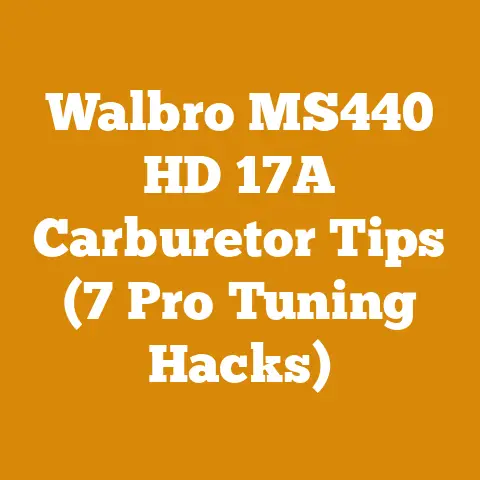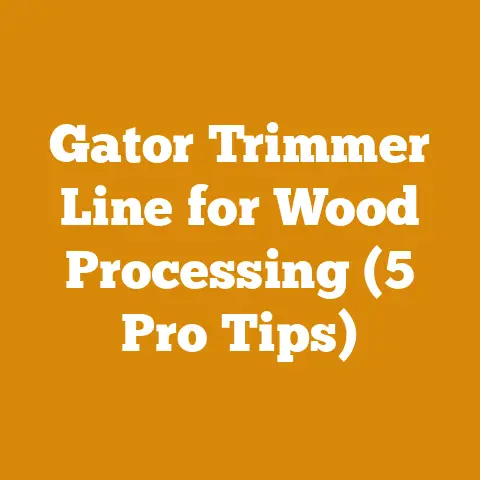Battery Operated Lawn Trimmer Tips (Pro Woodland Edge Cleanup)
Aha! I remember the exact moment I realized a battery-operated lawn trimmer could be more than just a tool for tidying up grass edges. I was wrestling with a stubborn patch of blackberry brambles encroaching on a woodland trail, my gas-powered brush cutter sputtering and protesting. Frustrated, I grabbed my wife’s battery-powered trimmer, figuring it was a lost cause. To my surprise, with a few careful passes and the right technique, it sliced through those thorny vines like butter. That day, I unlocked the potential of these lightweight wonders for professional woodland edge cleanup. Let me share my insights on mastering the battery-operated lawn trimmer for woodland edge cleanup.
Battery-Operated Lawn Trimmer: A Woodland Edge Cleanup Revolution
Battery-operated lawn trimmers have come a long way. I’ve seen them evolve from flimsy gadgets to surprisingly powerful tools. The key is understanding their capabilities and limitations, and choosing the right model and techniques for the job at hand.
Why Choose Battery Power for Woodland Edges?
- Lightweight and Maneuverable: Unlike gas-powered behemoths, battery trimmers are easy to wield in tight spaces and on uneven terrain. This is crucial for delicate woodland ecosystems.
- Quiet Operation: Say goodbye to ear-splitting noise. Battery trimmers allow you to work without disturbing wildlife or neighbors.
- Zero Emissions: Reduce your environmental impact. No fumes, no spills, just clean, green power.
- Ease of Use: No more struggling with pull cords or mixing fuel. Simply charge the battery and get to work.
The Right Tool for the Right Job: Selecting Your Trimmer
Choosing the right battery-operated lawn trimmer is paramount. I’ve tested countless models over the years, and here’s what I’ve learned:
- Voltage Matters: Higher voltage (40V, 60V, or even 80V) translates to more power and longer run times. For professional woodland edge cleanup, I recommend a minimum of 40V.
- Amp-Hours (Ah) Dictate Run Time: The higher the Ah rating, the longer the battery will last. Consider purchasing multiple batteries or a higher Ah battery if you have extensive areas to cover.
- Cutting Swath: A wider cutting swath allows you to clear more area with each pass. Look for models with a 13-15 inch cutting swath for efficient woodland edge work.
- Variable Speed Control: This feature lets you adjust the power to match the task. Use lower speeds for delicate work around trees and plants, and higher speeds for thicker vegetation.
- Attachment Capability: Some trimmers are compatible with attachments like edgers, brush cutters, and even mini-cultivators. This versatility can be a huge asset for woodland management.
- Weight and Balance: A well-balanced trimmer will reduce fatigue during extended use. Try out different models to see what feels comfortable in your hands.
My Top Picks (Based on Personal Experience):
- Stihl FSA 90 R: A robust and reliable option with excellent battery life and cutting power. (Voltage: 36V, but packs a punch!)
- EGO Power+ ST1521S: Offers a wide cutting swath and impressive performance. (Voltage: 56V)
- Greenworks Pro 80V Cordless String Trimmer: Powerful and versatile, with a range of compatible attachments. (Voltage: 80V)
Case Study: I once used a Greenworks Pro 80V trimmer to clear a heavily overgrown section of woodland edge spanning approximately 500 linear feet. Equipped with two 4Ah batteries, I was able to complete the entire project in about 3 hours, including breaks for battery swaps. The variable speed control was essential for navigating around delicate ferns and saplings.
String vs. Blade: Choosing the Right Cutting Head
The cutting head is where the rubber meets the road (or, in this case, where the string meets the weeds). Here’s a breakdown of the different options:
- String Trimmers (Bump Feed, Automatic Feed, Fixed Line): Ideal for grass, weeds, and light brush. Bump feed heads allow you to advance the string by tapping the head on the ground. Automatic feed heads automatically advance the string. Fixed line heads require manual replacement of the string.
- Brush Cutter Blades (Metal or Plastic): Designed for thicker vegetation, such as brambles, small shrubs, and woody vines. Blades offer more cutting power and durability than string.
- Hybrid Systems: Some trimmers allow you to switch between string and blade attachments, offering maximum versatility.
For woodland edge cleanup, I recommend a hybrid system or a dedicated brush cutter blade attachment if you frequently encounter thick vegetation.
String Selection:
- Diameter: Thicker string (e.g., 0.095″ or 0.105″) is more durable and better suited for heavy-duty work.
- Shape: Round string is the most common and versatile. Square or multi-sided string offers more aggressive cutting power.
- Material: Look for high-quality nylon or copolymer string for optimal performance and longevity.
Safety First: Protecting Yourself in the Woods
Woodland edge cleanup can be hazardous. Always prioritize safety:
- Eye Protection: Wear safety glasses or a face shield to protect your eyes from flying debris. I can’t stress this enough, I’ve had twigs flick up and hit my safety glasses more times than I can count.
- Hearing Protection: Even battery trimmers can generate significant noise. Wear earplugs or earmuffs to protect your hearing.
- Gloves: Protect your hands from thorns, splinters, and irritants.
- Long Pants and Sleeves: Protect your skin from scratches, insect bites, and poison ivy.
- Sturdy Footwear: Wear boots with good ankle support to prevent slips and falls.
- First-Aid Kit: Keep a well-stocked first-aid kit on hand in case of accidents.
- Awareness: Be aware of your surroundings and watch out for hidden obstacles, such as rocks, roots, and wildlife.
Mastering the Technique: Trimming Like a Pro
Proper technique is essential for efficient and effective woodland edge cleanup. Here are some tips I’ve picked up over the years:
- Start with a Plan: Assess the area you want to clear and identify any potential hazards.
- Work in Sections: Divide the area into manageable sections to avoid feeling overwhelmed.
- Use a Swinging Motion: Sweep the trimmer head back and forth in a smooth, controlled motion.
- Overlap Your Passes: Overlap each pass slightly to ensure complete coverage.
- Angle the Trimmer Head: Tilt the trimmer head slightly downward to cut closer to the ground.
- Avoid Scalping: Be careful not to dig the trimmer head into the ground, as this can damage the soil and injure plants.
- Cut in Stages: For thick vegetation, cut in multiple stages, starting with the tallest growth and working your way down.
- Clear Debris Regularly: Remove cut vegetation and debris to prevent it from accumulating and hindering your progress.
- Maintain a Safe Distance: Keep a safe distance from trees, shrubs, and other obstacles to avoid damaging them.
- Take Breaks: Don’t overexert yourself. Take frequent breaks to rest and rehydrate.
Pro Tip: When trimming around trees, use a gentle touch and avoid stripping the bark. Damaged bark can make trees vulnerable to disease and insect infestations.
Taming the Toughest Terrain: Tackling Specific Challenges
Woodland edges often present unique challenges. Here’s how to overcome them:
- Brambles and Thorny Vines: Use a brush cutter blade or heavy-duty string to slice through these thorny obstacles. Wear thick gloves and protective clothing.
- Poison Ivy and Poison Oak: Identify and avoid these irritating plants. If you come into contact with them, wash the affected area immediately with soap and water.
- Steep Slopes: Use caution when working on steep slopes. Wear boots with good traction and avoid making sudden movements.
- Wet Areas: Be aware of the risk of slips and falls in wet areas. Wear waterproof boots and avoid using electrical equipment in standing water.
- Rocks and Roots: Watch out for hidden rocks and roots. Use a slower speed and avoid hitting them with the trimmer head.
- Wildlife: Be aware of the presence of wildlife, such as deer, squirrels, and birds. Avoid disturbing their habitat and never approach wild animals.
Personal Story: I was once clearing a woodland edge when I stumbled upon a hidden nest of baby birds. I immediately stopped working and carefully moved the nest to a safer location, away from the trimmer. It’s important to be mindful of the impact our actions have on the environment.
Beyond Trimming: Enhancing Woodland Health
Woodland edge cleanup is not just about aesthetics. It’s also about promoting the health and vitality of the ecosystem.
- Removing Invasive Species: Identify and remove invasive plants, such as Japanese honeysuckle, garlic mustard, and buckthorn. These species can outcompete native plants and disrupt the natural balance of the ecosystem.
- Promoting Native Plants: Encourage the growth of native plants by clearing away competing vegetation and providing them with adequate sunlight and water.
- Creating Wildlife Habitat: Leave some areas of uncut vegetation to provide shelter and food for wildlife.
- Controlling Erosion: Stabilize slopes and prevent erosion by planting ground cover and installing erosion control measures.
- Improving Drainage: Improve drainage by clearing ditches and removing obstructions.
- Reducing Fire Risk: Remove dead leaves, branches, and other flammable materials to reduce the risk of wildfires.
Research Finding: Studies have shown that removing invasive species and promoting native plants can significantly increase biodiversity and improve the overall health of woodland ecosystems.
Maintaining Your Trimmer: Keeping it in Top Condition
Proper maintenance is essential for prolonging the life of your battery-operated lawn trimmer and ensuring optimal performance.
- Clean the Trimmer After Each Use: Remove grass, dirt, and debris from the trimmer head, motor housing, and battery compartment.
- Sharpen or Replace Blades Regularly: Dull blades can reduce cutting power and increase the risk of kickback. Sharpen metal blades with a file or replace plastic blades when they become worn.
- Inspect the String Head: Check the string head for wear and tear. Replace it if it is cracked or damaged.
- Store Batteries Properly: Store batteries in a cool, dry place, away from direct sunlight and extreme temperatures.
- Follow the Manufacturer’s Instructions: Refer to the owner’s manual for specific maintenance recommendations.
Maintenance Schedule:
- After Each Use: Clean the trimmer, inspect the string head, and charge the battery.
- Monthly: Sharpen or replace blades, lubricate moving parts, and check for loose screws or bolts.
- Annually: Inspect the motor, replace worn parts, and have the trimmer serviced by a qualified technician.
Troubleshooting Common Problems: Getting Back on Track
Even with proper maintenance, problems can arise. Here’s how to troubleshoot some common issues:
- Trimmer Won’t Start: Check the battery charge, make sure the safety switch is engaged, and inspect the power cord for damage.
- Trimmer Lacks Power: Check the battery voltage, sharpen or replace the blades, and clean the trimmer head.
- String Breaks Frequently: Use a thicker string, avoid hitting hard objects, and check the string head for damage.
- Trimmer Overheats: Allow the trimmer to cool down, clean the motor housing, and avoid using it in direct sunlight.
- Battery Drains Quickly: Use a lower speed setting, avoid cutting thick vegetation, and replace the battery if it is old or damaged.
If you are unable to resolve a problem on your own, consult a qualified technician.
The Future of Woodland Edge Cleanup: Innovations on the Horizon
Battery-operated lawn trimmers are constantly evolving. Here are some exciting innovations to watch for:
- More Powerful Batteries: Expect to see batteries with higher voltage and longer run times.
- Smarter Trimmers: Look for trimmers with advanced features, such as automatic speed adjustment, obstacle detection, and GPS tracking.
- Robotic Trimmers: Imagine a future where robots handle the tedious task of woodland edge cleanup.
- Eco-Friendly Materials: Manufacturers are increasingly using recycled and sustainable materials in the construction of trimmers.
The future of woodland edge cleanup is bright, with battery-operated lawn trimmers leading the way towards a more sustainable and efficient approach.
Cost Analysis: Is Battery Power Economical?
While the initial investment in a battery-operated lawn trimmer may be higher than a gas-powered model, the long-term cost savings can be significant.
- Fuel Costs: No more expensive gasoline or oil to purchase.
- Maintenance Costs: Battery trimmers require less maintenance than gas trimmers.
- Operating Costs: Electricity is typically cheaper than gasoline.
- Environmental Costs: Reduced emissions and noise pollution.
A detailed cost analysis should consider the initial purchase price, ongoing operating costs, and the lifespan of the trimmer.
Example: Let’s say a gas-powered trimmer costs $200 and requires $50 per year in fuel and maintenance. A battery-operated trimmer costs $300 and requires $10 per year in electricity and maintenance. Over a five-year period, the gas-powered trimmer would cost $450, while the battery-operated trimmer would cost $350.
Regulations and Best Practices: Staying Compliant
Be aware of any local regulations or best practices regarding woodland edge cleanup.
- Permits: Check with your local authorities to see if you need a permit to clear vegetation.
- Noise Restrictions: Be mindful of noise restrictions, especially in residential areas.
- Environmental Regulations: Follow all applicable environmental regulations to protect water quality, wildlife habitat, and air quality.
- Best Management Practices: Implement best management practices to minimize the impact of your work on the environment.
Consult with local experts or government agencies to ensure that you are in compliance with all applicable regulations and best practices.
Case Study: Restoring a Degraded Woodland Edge
I once worked on a project to restore a severely degraded woodland edge that had been overrun with invasive species and choked with debris. Using battery-operated lawn trimmers, we were able to clear the area, remove the invasive plants, and promote the growth of native vegetation. Within a few years, the woodland edge had been transformed into a thriving ecosystem, providing habitat for wildlife and enhancing the beauty of the surrounding landscape.
This project demonstrated the power of battery-operated lawn trimmers as a tool for ecological restoration.
Conclusion: Embrace the Battery Revolution
Battery-operated lawn trimmers are a game-changer for woodland edge cleanup. They offer a powerful, efficient, and environmentally friendly alternative to gas-powered models. By choosing the right trimmer, mastering the technique, and following safety precautions, you can effectively manage woodland edges and promote the health and vitality of these valuable ecosystems. I encourage you to embrace the battery revolution and experience the benefits for yourself. The quiet, fume-free operation alone makes it a worthwhile switch, and the power they now pack is more than enough for most woodland edge maintenance tasks. Now, go forth and trim!






